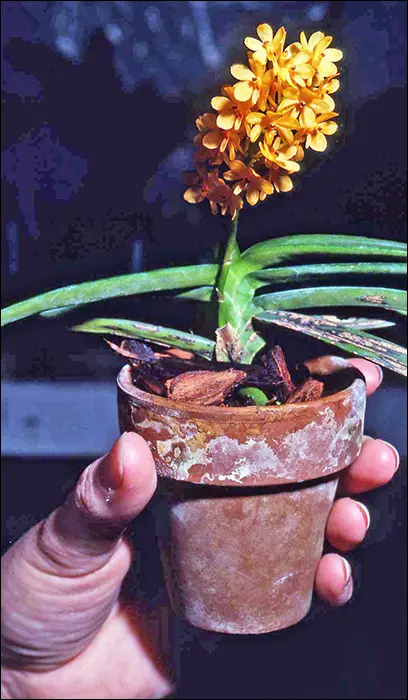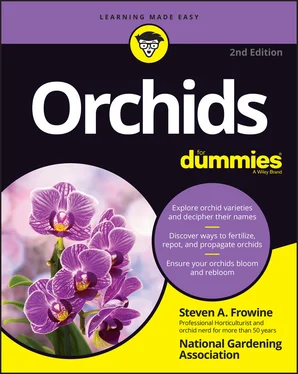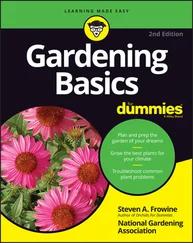 Here’s a checklist of things to look for when you select an orchid:
Here’s a checklist of things to look for when you select an orchid:
Look carefully at the leaves. They should be stiff, not shriveled or dehydrated. They should also have a healthy green color. Brown or black spots on leaves could mean disease, or they could be harmless; if you find spots, ask the grower about them.
Look for any signs of insects. Most insects hang out on the new young growth, on the flower buds of the plant, or on the undersides of the leaves. Also check under the pot for snails or slugs.
Examine the exposed roots on top of the potting material. The roots should be firm and light colored, not black, soft, and mushy.
Watch out for plants infested with oxalis (which looks like clover). Oxalis is an annoying weed that spreads quickly and is difficult to get rid of after it’s established. The only way to totally get rid of it is to remove all of its roots when you repot. It won’t directly harm the orchids, but it can harbor insects and is a cosmetic distraction.
 Make sure the plants are labeled. Labels will be important to you later if you want to look up information on growing your particular type of orchid.
Make sure the plants are labeled. Labels will be important to you later if you want to look up information on growing your particular type of orchid.
Unfortunately, orchids purchased at home centers or grocery stores aren’t often labeled. You can ask the sales associate if they at least know the common name of the orchid. Otherwise, you can look through this book until you find the orchid that looks something like the one you bought.
PLANT SIZE DESIGNATIONS USUALLY USED IN THE ORCHID TRADE BY MAIL-ORDER VENDORS
Many orchid vendors follow a convention when describing the relative maturity of the plants they’re selling. Here’s a rough guide to terms most used. As you can expect you’ll run into a bit of variation from grower to grower. Here are the size designations you’ll encounter:
Seedling Size (SS): The orchid will bloom in two to three years or more depending on the type of orchid.
Near Blooming or Flowering Size (NBS or NFS): The orchid is six months to a year or more from flowering.
Blooming/Flowering (BS/FS): The plant is the right size to flower.
In Spike: The orchid has started the process of flowering.
In Bud: The flower buds have formed but haven’t opened.
In Flower: At least some of the flowers have opened.
Already flowered: The orchid has already flowered at least once and is now out of bloom. Buying plants at this size and stage usually means the plant is well-established, which is greatly beneficial. Unfortunately, it can also mean the flower wasn’t that great when it flowered, which is why it hasn’t sold already. This last issue is more of a concern on seed-grown plants, not clones.
Sometimes vendors also list the pot size and/or the leaf spread. In general, a larger pot size indicates a larger plant, although that’s not always so.
As far as risk with shipping damage goes, plants in flower are the most delicate. If you’re impatient to see your new orchid in flower (and who isn’t?!) but you don’t want to risk the flowers being damaged in transit, specify that the plants be sent in low spike or low bud, if available, which means they’ve just started the process of flowering so are not as vulnerable to the vulgarities of shipping.
Deciding between a blooming plant and a young plant
When you buy a mature, blooming plant, you get to see exactly what the flower of this orchid is like. Because many orchid flowers can last quite a while, you’ll be able to enjoy this orchid for weeks after you bring it home. The biggest disadvantage of blooming plants is that they’re usually the most expensive, because they’re in the highest demand.
Younger plants — ones that are months or even years away from blooming — are much less expensive than their mature counterparts. The joy in choosing these plants is anticipating when they’ll bloom and what they may look like.
Choosing seed-grown orchids or orchid clones
Very few orchids sold today have been collected from the wild. Instead, they’ve been grown from seed. The flower color, flower size, and growth habits of these seed-grown plants vary. Seed-grown plants are generally very reasonably priced.
Cloned orchids, also referred to as meristemmed or mericloned orchids, are orchids that have been multiplied from single cells, usually from a plant of exceedingly high quality, in a flask, which is a type of laboratory bottle. The result is that they’re all identical.
 The advantage of purchasing a cloned orchid is that you can depend on the orchid that you buy being exactly like its parent, which is frequently an award winner. In general, these clones are a bit more expensive than the others, but they’re usually worth it.
The advantage of purchasing a cloned orchid is that you can depend on the orchid that you buy being exactly like its parent, which is frequently an award winner. In general, these clones are a bit more expensive than the others, but they’re usually worth it.
Selecting orchids with a sweet scent
Only second to the sheer beauty of the orchid flowers is the exquisite scent that some of them possess. No other family of plants that I know of offers such a wide range of delightful and sometimes repugnant fragrances. They can pleasantly surprise you with the appealing perfume of other flowers as well as fruits, candies, and foods (like chocolate and vanilla). Or, they can gross you out with putrid smell of carrion (to attract fly pollinators). In Part 3I introduce you to a selection of orchids that you may consider.
YOU ALWAYS HAVE ROOM FOR AN ORCHID
If you’re short of growing space and still want to try growing an orchid, don’t fret. Plenty of dwarf and miniature varieties can easily fit any growing area (see the following figure of an Ascocentrum garayi, which takes up very little space). Some are so small you need a magnifying glass to view their flowers! Part 3discusses some specific ones that are particularly suited to small spaces.

Isolating Your New Orchid after You Bring It Home
Adding new orchids to your plant collection is exciting, but this is also a time for caution. Even though you may have been careful in the selection process, your orchid still may be harboring insect eggs that may hatch, or it may have a disease problem that you didn’t notice before.
 So, to be on the safe side, keep your new plant isolated from all your other plants for at least two to three weeks — enough time to see if any insects appear or a disease shows up. If you need to treat your new plant, doing so will be easier when it’s separated from your other plants.
So, to be on the safe side, keep your new plant isolated from all your other plants for at least two to three weeks — enough time to see if any insects appear or a disease shows up. If you need to treat your new plant, doing so will be easier when it’s separated from your other plants.
To identify pests and their safest treatment, see Chapter 9.
Конец ознакомительного фрагмента.
Текст предоставлен ООО «ЛитРес».
Прочитайте эту книгу целиком, купив полную легальную версию на ЛитРес.
Читать дальше

 Here’s a checklist of things to look for when you select an orchid:
Here’s a checklist of things to look for when you select an orchid: Make sure the plants are labeled. Labels will be important to you later if you want to look up information on growing your particular type of orchid.
Make sure the plants are labeled. Labels will be important to you later if you want to look up information on growing your particular type of orchid.











